上海版牛津英语B教案优选稿
《上海牛津英语2BUint5》优秀教案
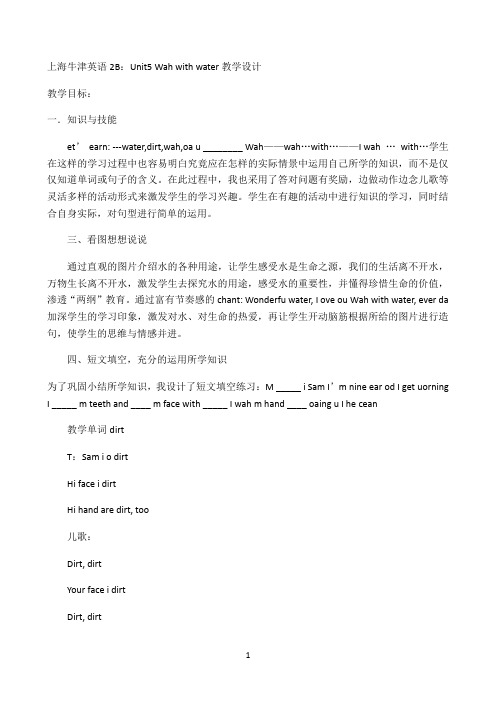
上海牛津英语2B:Unit5 Wah with water教学设计教学目标:一.知识与技能et’earn: ---water,dirt,wah,oa u ________ Wah——wah…with…——I wah …with…学生在这样的学习过程中也容易明白究竟应在怎样的实际情景中运用自己所学的知识,而不是仅仅知道单词或句子的含义。
在此过程中,我也采用了答对问题有奖励,边做动作边念儿歌等灵活多样的活动形式来激发学生的学习兴趣。
学生在有趣的活动中进行知识的学习,同时结合自身实际,对句型进行简单的运用。
三、看图想想说说通过直观的图片介绍水的各种用途,让学生感受水是生命之源,我们的生活离不开水,万物生长离不开水,激发学生去探究水的用途,感受水的重要性,并懂得珍惜生命的价值,渗透“两纲”教育。
通过富有节奏感的chant: Wonderfu water, I ove ou Wah with water, ever da 加深学生的学习印象,激发对水、对生命的热爱,再让学生开动脑筋根据所给的图片进行造句,使学生的思维与情感并进。
四、短文填空,充分的运用所学知识为了巩固小结所学知识,我设计了短文填空练习:M _____ i Sam I’m nine ear od I get uorning I _____ m teeth and ____ m face with _____ I wah m hand ____ oaing u I he cean教学单词dirtT:Sam i o dirtHi face i dirtHi hand are dirt, too儿歌:Dirt, dirtYour face i dirtDirt, dirtYour hand are dirtT:Sam i o dirtWhat can he do nethand自编儿歌:Wah, wahI can wahWah, wahWah m ________T: what can we wah withLiten:waterT: what do ou hear引出waterS: read the wordT: water i wonderfu We can do man thing with waterWe drin water ever daWe wim in the waterFiremen er grow hand with water2 Wah m face with water3 Wah S face with waterI wah…with waterI wah m face with oa face with water But I can’t wah it cean So I can wah m face with oauch oaNice oa I’m nine ear od I get uorning I _____ m teeth and ____ m face with _____ I wah m hand ____ oa I go to choo ___ bu I fee ha ever daT: How do we ave water1 reue the water2 don’t a with water3 turn off the taRead P23 twice在问答和唱歌的过程中,既复习了旧知识,又在不知不觉中拓展了思维,为新授课做好准备。
牛津英语上海版2B教案
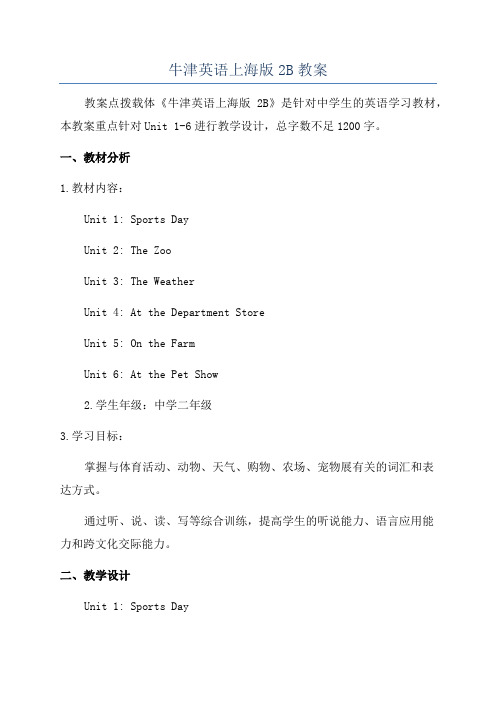
牛津英语上海版2B教案教案点拨载体《牛津英语上海版2B》是针对中学生的英语学习教材,本教案重点针对Unit 1-6进行教学设计,总字数不足1200字。
一、教材分析1.教材内容:Unit 1: Sports DayUnit 2: The ZooUnit 3: The WeatherUnit 4: At the Department StoreUnit 5: On the FarmUnit 6: At the Pet Show2.学生年级:中学二年级3.学习目标:掌握与体育活动、动物、天气、购物、农场、宠物展有关的词汇和表达方式。
通过听、说、读、写等综合训练,提高学生的听说能力、语言应用能力和跨文化交际能力。
二、教学设计Unit 1: Sports Day1. Warm-up Activity: Have a class discussion about favorite sports, ask students to share their opinions and reasons.2. Vocabulary: Introduce new vocabulary related to sports, such as running, jumping, swimming, etc. Use flashcards and real objects to help students understand and memorize the words.3. Listening: Play a recording of a sports event, ask students to listen and answer questions about the participants and their performance. Have a class discussion about the sports event.4. Speaking: Organize a mini sports day in the classroom. Divide the class into groups and assign different sports to each group. Students will take turns performing their chosen sports and describing their actions in English.6. Writing: Ask students to write a paragraph about their favorite sports and why they like it. Provide sentence starters and vocabulary to support their writing.Unit 2: The Zoo1. Warm-up Activity: Show students pictures of different animals, ask them to identify the animals and describe their characteristics.2. Vocabulary: Introduce new vocabulary related to animals, such as lion, elephant, giraffe, etc. Use flashcards and real pictures to help students understand and remember the words.3. Listening: Play a recording about a visit to the zoo, ask students to listen and answer questions about the animals seenat the zoo. Discuss the experience as a class.4. Speaking: Organize a group presentation about different animals. Each group will research and present information about an assigned animal, including its physical characteristics, habitat, and behavior.6. Writing: Ask students to write a paragraph about their favorite animal and describe its appearance and characteristics. Provide sentence starters and vocabulary to support their writing.Unit 3: The Weather1. Warm-up Activity: Review previous knowledge about different types of weather. Ask students to share their favorite weather and reasons.2. Vocabulary: Introduce new vocabulary related to weather, such as sunny, rainy, windy, etc. Use flashcards and pictures to help students understand and remember the words.3. Listening: Play a weather report recording, ask students to listen and identify the weather conditions mentioned. Discuss the weather conditions and their impact on activities.4. Speaking: Organize a weather forecast presentation. Each group will research and present a weather forecast for a chosencity, including the current weather conditions and predictionsfor the next few days.6. Writing: Ask students to write a short weather report fora chosen city. Provide sentence starters and vocabulary to support their writing.Unit 4: At the Department Store2. Vocabulary: Introduce new vocabulary related to department store items, such as clothes, shoes, bags, etc. Use flashcards and real objects to help students understand and remember the words.3. Listening: Play a conversation between a customer and a shop assistant in a department store, ask students to listen and answer questions about the customer's needs and the shopassistant's suggestions. Discuss the conversation as a class.4. Speaking: Organize a role play activity where studentsact as customers and shop assistants. They will take turns practicing conversations in a department store setting, focusing on making inquiries and providing suggestions.6. Writing: Ask students to write a short letter to a friend, describing a shopping experience in a department store. Provide sentence starters and vocabulary to support their writing.Unit 5: On the Farm1. Warm-up Activity: Show pictures of different farm animals, ask students to identify the animals and describe their appearances and behaviors.2. Vocabulary: Introduce new vocabulary related to farm animals, such as cow, sheep, chicken, etc. Use flashcards, videos, and real objects to help students understand and remember the words.3. Listening: Play an audio recording about life on a farm, ask students to listen and answer questions about the daily activities and responsibilities of farmers. Discuss therecording as a class.4. Speaking: Organize a class discussion about farming andits importance. Ask students to share their thoughts on why farming is important and the challenges faced by farmers.6. Writing: Ask students to write a diary entry about avisit to a farm. Provide sentence starters and vocabulary to support their writing.Unit 6: At the Pet Show1. Warm-up Activity: Show pictures of different pets, ask students to identify the pets and share their experiences with pets.2. Vocabulary: Introduce new vocabulary related to pets,such as cat, dog, rabbit, etc. Use flashcards and real picturesto help students understand and remember the words.3. Listening: Play a conversation between pet owners at apet show, ask students to listen and answer questions about the pets being shown and their unique features. Discuss the conversation as a class.4. Speaking: Organize a pet show in the classroom. Each student will bring a toy pet and present it to the class, describing its special features and characteristics.6. Writing: Ask students to write a short paragraph about their ideal pet and why they would choose it. Provide sentence starters and vocabulary to support their writing.以上是《牛津英语上海版2B》教学设计的主要内容,根据课程特点和教学目标,选择了适合学生的各种教学活动和评估手段。
沪教牛津英语2b教案
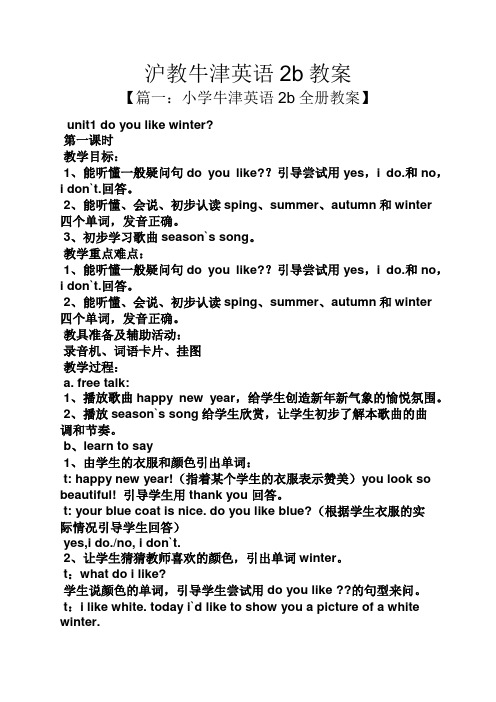
沪教牛津英语2b教案【篇一:小学牛津英语2b全册教案】unit1 do you like winter?第一课时教学目标:1、能听懂一般疑问句do you like??引导尝试用yes,i do.和no,i don`t.回答。
2、能听懂、会说、初步认读sping、summer、autumn和winter四个单词,发音正确。
3、初步学习歌曲season`s song。
教学重点难点:1、能听懂一般疑问句do you like??引导尝试用yes,i do.和no,i don`t.回答。
2、能听懂、会说、初步认读sping、summer、autumn和winter四个单词,发音正确。
教具准备及辅助活动:录音机、词语卡片、挂图教学过程:a. free talk:1、播放歌曲happy new year,给学生创造新年新气象的愉悦氛围。
2、播放season`s song给学生欣赏,让学生初步了解本歌曲的曲调和节奏。
b、learn to say1、由学生的衣服和颜色引出单词:t: happy new year!(指着某个学生的衣服表示赞美)you look so beautiful! 引导学生用thank you 回答。
t: your blue coat is nice. do you like blue?(根据学生衣服的实际情况引导学生回答)yes,i do./no, i don`t.2、让学生猜猜教师喜欢的颜色,引出单词winter。
t:what do i like?学生说颜色的单词,引导学生尝试用do you like ??的句型来问。
t:i like white. today i`d like to show you a picture of a white winter.教师出示冬天的图片,引出winter,组织学生听单词录音,朗读单词。
3、以相同的方法学习单词sping、summer、autumn。
上海版牛津小学英语2b教案全册 2B教案U9_3

第三课时(THE THIRD PERIOD)一.主要内容(Main contents)Let’ revise --- 复习句型:Look at…I hear…I wash … with …It’s … o’clock.I can …二.学习目标(Learning objectives)1.能正确使用学过的句型进行表达2.创设各种情景和布置各类学习任务,让学生复习本学期学过的句型。
3.培养学生举一反三的能力和综合使用句型的能力。
三.教学建议(Teaching suggestion)1.任务前期准备阶段(Pre-task preparation section)Pre-task preparation 是指我们在进入语言学习之前,让学生获得对即将学习的语言材料的第一次感知,让学生尽快进入学习状态的前期准备阶段。
通过创建一种愉快的英语学习氛围,把学生自然地带入到复习的气氛中。
Activity 1 (Song)1、教学辅助(Aids)1) 电脑(2B-U9-1)2)屏幕3)录音机Activity 2 (Rhyme)1、教学辅助(Aids)1)电脑(2B-U9-2)、(2B-U9-3)2)屏幕2.活动过程(Process)2、任务中期实施阶段(While-task procedure section )While-task Procedure ,这是指语言技能的习得过程。
其中分为机械性操练和意义性操练两部分。
机械性操练:让学生准确地模仿、复说要学习的知识,从模仿到识记,使新知识由感知、理解、模仿直到储存。
Activity 1(Discuss ) 1、教学辅助(Aids) 1) 电脑(2B-U9-4) 2)屏幕Activity 2 (What time is it?) 1、教学辅助(Aids) 1)电脑(2B-U9-5) 2)屏幕完成比较扎实的机械性操练后,就进入了意义性操练阶段。
意义性操练是介于机械性操练和交际性操练之间,起着承上启下的作用,把语言形式的操练转向语言内容的操练,使学生的认知逐步从知识外部特征转向知识内在的联系。
2B Unit1 period 1(上海版牛津英语教案)
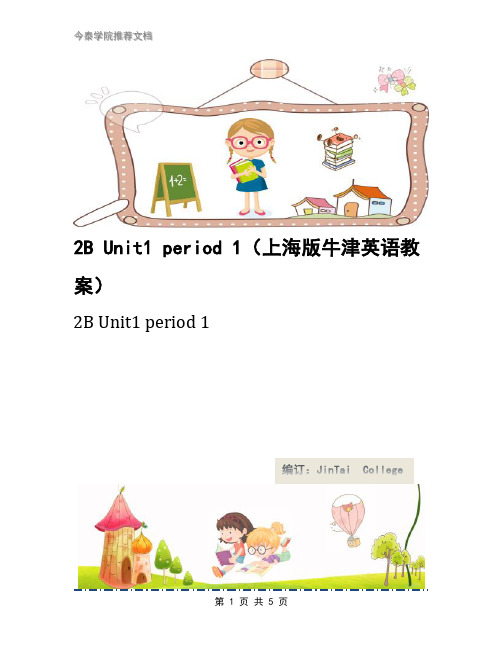
2B Unit1 period 1(上海版牛津英语教案)2B Unit1 period 12B Unit1 period 1(上海版牛津英语教案)前言:小泰温馨提醒,英语作为在许多国际组织或者会议上都是必需语言,几乎所有学校选择英语作为其主要或唯一的外语必修课。
英语教学涉及多种专业理论知识,包括语言学、第二语言习得、词汇学、句法学、文体学、语料库理论、认知心理学等内容。
本教案根据英语课程标准的要求和针对教学对象是小学生群体的特点,将教学诸要素有序安排,确定合适的教学方案的设想和计划、并以启迪发展学生智力为根本目的。
便于学习和使用,本文下载后内容可随意修改调整及打印。
lesson planschool: penglai no.2 primary schoolname: zhang yingyingbook: oxford english (shanghai edition)2b unit 1topic: farm animalaims: 1.structures: draw the cow on the paper.2.word: cow3.function: using "draw … on the paper".language focus: using imperatives to give simple instructions.aids: pictures, realiaprocedures contentsmethodspurpose i.pre-taskpreparation1. warming-up ps: sing a song about animals.1.通过歌曲,让学生对动物有初步的印象。
2.描述动物,为课文最后的综合练习打下基础。
3.帮助学生辨别什么是野生动物,什么是农场里动物,丰富学生的知识,进一步激发他们学习的兴趣。
2. questions and answers which animal do you like best? why?which animal do you have as a pet?do you like …?t: ask pupils to answer the : answer.pa: ask questions.pb: answer.3. quick response tigers, sheep, elephants, crocodiles, ducks, cows (show the pictures)ps: farm animals.ps: wildanimals.ii.while-taskprocedure content 1: cow1.introduction:t: elicit ‘cow’ from the previous game. what’s this?2.imitation: cow1) t: ask pupils to follow.t-ps2) t: spell the word.pa-pb-pn通过机械性的仿说及拼读,使学生对所学单词基本掌握。
沪教版牛津英语B教案

(此文档为word格式,下载后您可任意编辑修改!) The Allocation for Grade 2B2B Unit 1 Farm animals 【单元分析(UNIT ANALYSIS)】一.教材地位(UNIT POSITION)1.从第一、二单元“动物”的主题来看,本单元教材内容是着重围绕“农场上的动物”这个课题展开。
2.在一年级,学生已会用口语表达I’ve got…以及I see a …句型,在此基础上,本单元巩固了这些句型,并通过有关动物词汇的累积和问答句的使用丰富了句子表述的语意。
3.在本册教材中,学生将继续识认书写大小写字母。
4.本单元学生将学习农场上常见的六种动物:, chick, duck, cow, sheep, pig及其相关表述。
5.结合本单元“农场”、“动物”的主题和语境,无论学生是否熟悉农场的环境,都可以让学生通过听觉和视觉感受农场上最常见的人类驯养的动物和野生动物,并且用习得的语言简单表达出自己的所见所闻。
二.学习目标(LEARNING OBJECTIVES)1.本单元学习Oo 、Nn两个字母,字母的教学可与单词教学相结合,要求学生不仅能按字母表顺序背诵字母,能正确认读大小写字母之外,还能正确掌握所学字母大小写的书写。
2.学生应该能够用正确的语音语调表达hen, chick, duck, cow, sheep, pig等动物名称,掌握这些词汇的认读、拼读、简单运用等口语表达;能够正确书写这些单词。
除此之外,可根据学生的学习能力在口语学习中适当增加所学动物的复数表达。
培养学生的视听观察能力,能根据实际情况运用What do you see animals 【单元分析(UNIT ANALYSIS)】三.教材地位(UNIT POSITION)1.从第一、二单元“动物”的主题来看,本单元教材内容是着重围绕“农场上的动物”这个课题展开。
2.在一年级,学生已会用口语表达I’ve got…以及I see a …句型,在此基础上,本单元巩固了这些句型,并通过有关动物词汇的累积和问答句的使用丰富了句子表述的语意。
上海版牛津英语2B课程教案

Period 5 Let’s enjoy.Contents: story: I’ve got a cow. It goes ‘moo, moo’.Aims: ⒈Using formulaic expressions to indicate possessions. e.g. I’ve got a cow.⒉Using formulaic expressions to indicate what noise animalsmake. e.g. It goes ‘moo, moo’.Main points: Using formulaic expressions to indicate possessions and what noise animals make.Difficulties: Pronounce correctly words in connected speech by linking together and using appropriate stress.Aids: Student’s Book, tape, a toy animal2B Unit 1 Farm AnimalsPeriod 1 Let’s learnContents: 1.Word: hen, chick, duck, cow, pig2.Letter: N n nose, O o orangeAim: ing nouns to identify common farm animals.e.g. hen, chick2.Learn the above names and sounds of the letters ‘N n, O o’.3.Knowning about the farm animals and say something aboutthe animals you like.Main points: Using nouns to identify common farm animals. Difficulties: Pronounce words properly.Aids: 1.T: picture cards, words cards, tape, Student’s Book and Wordbook.P: picture cards (students prepared beforehand )Period 2 Let’s talkContents: What do you see? I see┄What do you hear? I hear┄Aims: 1. Asking ‘wh’questions to find out specific information about a farm.e.g. What do you see /hear?2.Using the simple present tense. e.g. I see/hear a duck.Main Points: Asking and answering the ‘wh’questions. Difficulties: Using the models to communicate with other learners. Aids: the wallchart for page 3, six picture cards and six word cards ,tape , Student’s Book and WorkbookProcedures:ⅠPre-task preparation⒈Show six toy farm animals or pictures of them.Ask students to name in English.⒉Show sixword cards. Ask students to read them.Period 3 Let’s actContents: Draw the cow on the paper. Draw the duck on the ground. Aims: ⒈Using imperatives to give simple instructions. e.g. Draw the cow on the paper.⒉Locating specific information in response to simple instructions.⒊Using modeled phrases to communicate with other learners. Main points: Using imperatives to give simple instructions. Difficulties: Using modeled phrases to communicate with other learners. Aids: plain sheets of paper, toy animals, animal picture cards, tape, Workbook, Student’s BookPeriod 4. Let’s play.Contents: Listen, tick and say: I hear a…Aims: ⒈Using the simple present tense to indicate what you hear. e.g. I hear a sheep.2. Using nouns to refer to farm animals. e.g. cowMain points: Using the simple present tense to indicate what you hear. Difficulties: Recognizing key words of the animals.Aids: Student’s Book and Workbook, tape, word and picture cards2B Unit2 In the circus Period1 Let’s act Teaching aims:1)Locate specific information in response to simple instructions.2)Use imperatives to give simple instructions.3)Learn the sentences: Come here. Go there. Come back . Education aims:Foster the thought of loving animals.Difficult points:Using imperatives to give simple instructions.Materials:Cassette 2B and cassette player.Animal masksTeaching essay2B Unit2 In the circus Period2 Let’s learn Teaching aims:1)Learn the words: horse, bear, elephant, tiger, monkey, panda.2) Pronounce words properly.Education aims:Foster the thought of loving animals.Difficult points:Using nouns to identify animals.e. g. bear, elephantMaterials:Cassette 2B and a cassette player.Wookbook 2B page 6.Animal masks.Teaching essay2B Unit2 In the circus Period3 Let’s talk Teaching aims:1)Learn the sentences: Look at the…It’s…and…2) Use imperatives to draw attention to something.3 ) Use adjectives to describe animals.Education aims:Foster the thought of loving animals.Difficult points:Use imperatives to draw attention to the animals and describe them.Materials:Cassette 2B and a cassette playerWord and picture cards (animals)Wallchart 2BAnimalsTeaching essay2B Unit 2 Period 4 In the circus Letters Basic aim: ing nouns to identify things.. .. e.g. pencil, quilt.2. Learning the letters: Pp , Qq.Difficult point: Writing the lettersTeaching essay2B Unit 2 Period 5 Let’s play Guess Who’s my friend? Basic aim:ing connectives to link two adjectives.e.g. She is little and white.2.Asking “Wh-’’questions to find out specific information abouta person.e.g. Who is she?Developing aims:1.Learn other words. e.g. tail,short.2.Make a riddle.Materials: cassette,player,toys,masks.Teaching procedure:Teaching essayUnit 2 Let’s enjoyPeriod 6 Song Basic aim:ing imperatives to draw attention to somethinge. g. Look at the bear.ing adjectives to describe animalse. g. It’s big and brown.Developing aims:1.Rhyme2.Like animals, like nature.Materials:Cassette, player, pictures, masks.Teaching procedure:Teaching essayUNIT 3 Let’s learnPeriod 1Teaching aims:1.Basic aims: a. To learn the letters: Rr Ss.b. To learn the words: rubber, sweet.c. Add a new word: chocolate.2.Developing aims: using the words to make some sentences, make some dialogues or some rhymes.Main points: To learn the letters and the words.Difficult points: The pronunciation of ‘Rr’.Materials: letter cards, picture cards, cassette.Teaching essayUNIT 3 Let’s learnPeriod 2Teaching aims:1.Basic aims:To learn the seven words: window, door, bed, room, sofa, table, lamp.2.Developing aims: Using the words to describe a room.Main points: To learn the words.Difficult points: Using some English to describe the words. Materials: cassette, picture cards, a big picture of a room.Teaching essayUNIT 3 Let’s actPeriod 3Te aching aims:1.Basic aims: Using imperative to give simple instructions: Close the window, please.2. Developing aims: Using imperative in the correct situation. Main points and difficult points:Use modelled phrases to communicate with other learners. Materials: cassette, picture cards, the picture of ‘my room’Teaching essay2B UNIT 3 Let’s talkPeriod 4Teaching aims:1.Basic aims:(1)Using the simple present tense to indicate facts. E.g. This is myroom.(2)Using introductory ‘There’to express facts. E.g. There is / are…in my room.2. Developing aims: T o describe one place using ‘There is/are…’. Education aims: Let the students to love their homes.Main points and difficult points:Using ‘This is …’‘There is/are …’to express facts. Materials: cassette, the tape of listening( 2parts),the tape of the sounds(the admire and bewail sounds),some pictures, cards. etc.。
上海版牛津英语B全册教学导案(含单元分析)

上海版牛津英语B全册教案(含单元分析)————————————————————————————————作者:————————————————————————————————日期:教学进度表(英语)周次日期计划进度备注1 3.4~3.8Unit 1 New Year ②2 3.11~3.15Unit 1 New Year ②3 3.18~3.22Unit 2 Small animals ②4 3.25~3.29Unit 2 Small animals ①Unit 3 Colors①5 4.1~4.5Unit 3 Colors②6 4.8~4.12Unit 3 Colors①Unit 4 Postman and policeman ①7 4.15~4.19Unit 4 Postman and policeman ②8 4.22~4.26Unit 5 Doctor and nurse ②9 4.29~5.3 Unit 5 Doctor and nurse ②10 5.6~5.10Unit 6 Farmer and fisherman ②11 5.13~5.17 Unit 6 Farmer and fisherman ①Unit 7 Birthday party①12 5.20~5.24Unit 7 Birthday party②13 5.27~5.31Unit 7 Birthday party①Unit 8 Dinner①14 6.3~6.7Unit 8 Dinner②15 6.10~6.14Unit 8 Dinner① Unit 9 Revision①16 6.17~6.21Unit 9 Revision②课标要求听做:1、能根据听到的词语识别或指认图片或实物;2、能听懂课堂简短的指令并做出相应的反应;3、能根据指令做事情,如:指图片、涂颜色、画图、做动作、做手工等;4、能在图片和动作的提示下听懂简单的小故事并做出反应。
上海版牛津英语B教案图文稿

上海版牛津英语B教案集团文件版本号:(M928-T898-M248-WU2669-I2896-DQ586-M1988)Unit 7 Hot SummerPeriod 1Education Aims:Don’t leave rubbish on the beach. Teaching Aims:1.Basic aims.A: To learn the words: beach, shells B: To learn the drills.e. g. Let’s go to the beach.2.Developing Aims:A: Say another sentences.e.g. Let’s pick up rubbish.B: Free talk.Materials:Cassette player, pictures, objects Teaching Procedure:课后小结Unit 7 Hot SummerPeriod 2 Let’s talk Education Aims:To be friendly each other .Teaching Aims:1.Learn the drills.e.g. Summer is hot .2.Learn the dialogue.A: I’m sorry.B: It’s OK.Materials: cassette player, pictures, objects. Teaching Procedure:课后小结Unit 7 Hot summerPeriod 3 Let’s learn Education Aims:Don’t eat much ice-cream in summer.Teaching Aims:1.Learn the words: e.g. cloud2.Learn the letter: Y yMaterials: cassette player, word and letter cards.Teaching procedure:课后小结Period 4 Let’s play Education Aims:Don’t eat too many ice-creams.Teaching Aims:A: Basic Aims.Learn to say the sentences.e.g. The sun is hot.Let’s sit under the umbrella.B: Developing Aims.Free talk about winter.Materials: cassette player, some pictures, cards Ask the pupils to make some pictures before class. Teaching Procedure:课后小结Period 5 Let’s enjoyEducation Aims:To be friendly each other .Teaching Aims:A: Basic Aims:Learn to say the rhyme.B: Developing Aims:Free talk.Materials: cassette player, pictures.]Teaching Procedure:课后小结。
上海版牛津英语B教案

上海版牛津英语B教案一、教学目标1.了解上海版牛津英语B教材的教学内容和教学重点;2.掌握适合上海版牛津英语B教材的教学方法和教学技巧;3.能够根据教学目标设计合理的教学计划;4.能够评估学生的学习情况,合理调整教学策略。
二、教学内容上海版牛津英语B教材是根据《上海版英语教学大纲》编写的,内容涵盖了语音、词汇、语法、听力、口语、阅读、写作等方面的知识点,适合小学英语教学。
具体教学内容分为六个单元,包括“Hello, My Friend!”、“My Classroom”、“My Body”、“My Family”、“My Home”和“Happy Holidays”。
三、教学重点和难点1.教学重点:掌握和运用本教材中的基础词汇和句型,并能够进行简单的日常对话;2.教学难点:培养学生的听说能力,提高学生的英语应用能力。
四、教学方法和教学技巧1.使用多媒体教具,进行图片和音频的辅助教学;2.运用情境教学法,营造真实的语言环境;3.采用小组合作学习和个别指导相结合的方式,提高学生的学习积极性和主动性;4.借助游戏和活动,增加语言输入和输出的机会。
五、教学计划第一课时:Unit 1 Hello, My Friend!教学目标:学会问候并进行简单的自我介绍。
教学重点和难点:学会问候的表达方式和进行简单的自我介绍。
教学内容和过程:Step 1. Greetings (10分钟)-学生与教师进行问候,学习如何用英语进行问候。
- 教师出示图片,教学“Hello!”和“How are you?”的表达方式。
-播放相关的听力材料,让学生听并模仿。
-学生两两进行问候练习。
Step 2. Presentation (15分钟)-教师出示英文名片,与学生进行简单的自我介绍。
-引导学生用英语介绍自己的名字和一些个人信息,如年龄、爱好等。
-学生两两进行自我介绍练习。
Step 3. Consolidation (15分钟)-听力练习:播放录音,让学生根据录音内容选择正确的答案。
上海版牛津小学英语B教学计划教案
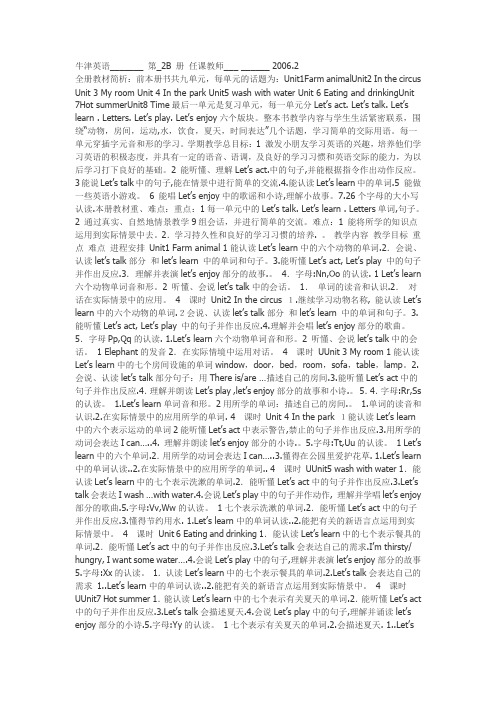
牛津英语_______ 第_2B 册任课教师___ ______ 2006.2全册教材简析:前本册书共九单元,每单元的话题为:Unit1Farm animalUnit2 In the circus Unit 3 My room Unit 4 In the park Unit5 wash with water Unit 6 Eating and drinkingUnit 7Hot summerUnit8 Time最后一单元是复习单元,每一单元分Let’s act. Let’s talk. Let’sl earn . Letters. Let’s play. Let’s enjoy六个版块。
整本书教学内容与学生生活紧密联系,围绕“动物,房间,运动,水,饮食,夏天,时间表达”几个话题,学习简单的交际用语。
每一单元穿插字元音和形的学习。
学期教学总目标:1 激发小朋友学习英语的兴趣,培养他们学习英语的积极态度,并具有一定的语音、语调,及良好的学习习惯和英语交际的能力,为以后学习打下良好的基础。
2 能听懂、理解Let’s act.中的句子,并能根据指令作出动作反应。
3能说Let’s talk中的句子,能在情景中进行简单的交流.4.能认读Let’s learn中的单词.5 能做一些英语小游戏。
6 能唱Let’s enjoy中的歌谣和小诗,理解小故事。
7.26个字母的大小写认读.本册教材重、难点:重点:1每一单元中的Let’s talk. Let’s learn . Letters单词,句子。
2 通过真实、自然地情景教学9组会话,并进行简单的交流。
难点:1 能将所学的知识点运用到实际情景中去。
2.学习持久性和良好的学习习惯的培养. 。
教学内容教学目标重点难点进程安排Unit1 Farm animal 1能认读Let’s learn中的六个动物的单词.2.会说、认读let’s talk部分和let’s learn 中的单词和句子。
上海版牛津英语B教案修订稿

上海版牛津英语B教案集团档案编码:[YTTR-YTPT28-YTNTL98-UYTYNN08]Unit 7 Hot SummerPeriod 1 Education Aims:Don’t leave rubbish on the beach.Teaching Aims:1.Basic aims.A: To learn the words: beach, shellsB: To learn the drills.e. g. Let’s go to the beach.2.Developing Aims:A: Say another sentences.. Let’s pick up rubbish.B: Free talk.Materials:Cassette player, pictures, objectsTeaching Procedure:课后小结Unit 7 Hot SummerPeriod 2 Let’s talk Education Aims:To be friendly each other .Teaching Aims:1.Learn the drills.. Summer is hot .2.Learn the dialogue.A: I’m sorry.B: It’s OK.Materials: cassette player, pictures, objects. Teaching Procedure:Unit 7 Hot summerPeriod 3 Let’s learnEducation Aims:Don’t eat much ice-cream in summer.Teaching Aims:1.Learn the words: . cloud2.Learn the letter: Y yMaterials: cassette player, word and letter cards.课后小结Period 4 Let’s playEducation Aims:Don’t eat too many ice-creams.Teaching Aims:A: Basic Aims.Learn to say the sentences.. The sun is hot.Let’s sit under the umbrella.B: Developing Aims.Free talk about winter.Materials: cassette player, some pictures, cards Ask the pupils to make some pictures before class.课后小结Period 5 Let’s enjoyEducation Aims:To be friendly each other .Teaching Aims:A: Basic Aims:Learn to say the rhyme.B: Developing Aims:Free talk.Materials: cassette player, pictures.。
上海版牛津英语2B教案

Period 5 Let’s enjoy.Contents: story: I’ve got a cow. It goes ‘moo, moo’.Aims: ⒈Using formulaic expressions to indicate possessions. e.g. I’ve got a cow.⒉Using formulaic expressions to indicate what noise animals make. e.g. Itgoes ‘moo, moo’.Main points: Using formulaic expressions to indicate possessions and what noise animals make.Difficulties: Pronounce correctly words in connected speech by linking together and using appropriate stress.2B Unit 1 Farm AnimalsPeriod 1 Let’s learnContents: 1.Word: hen, chick, duck, cow, pig2.Letter: N n nose, O o orangeAim: ing nouns to identify common farm animals.e.g. hen, chick2.Learn the above names and sounds of the letters ‘N n, O o’.3.Knowning about the farm animals and say something about the animalsyou like.Main points: Using nouns to identify common farm animals.Difficulties: Pronounce words properly.Aids: 1.T: picture cards, words cards, tape, Student’s Book and Wordbook.P: picture cards (students prepared beforehand )Period 2 Let’s talkContents: What do you see? I see┄What do you hear? I hear┄Aims: 1. Asking ‘wh’ questions to find out specific information about a farm.e.g. What do you see /hear?2.Using the simple present tense. e.g. I see/hear a duck.Main Points: Asking and answering the ‘wh’ questions.Difficulties: Using the models to communicate with other learners.Aids: the wallchart for page 3, six picture cards and six word card s ,tape , Student’s Procedures:ⅠPre-task preparation⒈Show six toy farm animals or pictures of them. Askstudents to name in English.⒉Show six word cards.Ask students to read them.⒊Match the words to the pictures on the board.⒋Ask: ①What comes from a hen?/ Where does an eggcome from?②Where does milk/a chick /a hen come from?Ⅱ. While-task procedure⒈While putting your hands on your eyes like a telescope,say ‘What do you see?’Then putting your hand on yourear lik e listening, say ‘What do you see?’ Getthe students to do the actions like you while repeating thequestions after you.⒉Put up the wallchart for page 3 tell a story something likethis:T: Look at the picture of a farm. This boy is Sam andthis gir l is May. They’re brother and sister. This old manis their grandfather. Sam and May sometimes go to thecountry to visit their grandfather. Their grandfather is afarmer. Sam and May like to go to his farm to see theanimals. There are a lot of animals on the farm: a pig,sheep, cows, a duck and even a hen with baby chicks.How many of them do you see in the picture? S: I see…⒊Play the sounds of the animals on the recording andanswer the questions ‘What do you hear?’bysaying ‘I hear…’⒋Listen to the story again. Then answer the questionsand such as the following:①Who is the boy/girl/old man? (Sam, May, grandfather)②What is Sam and May’s grandfather? (He is a farmer.)③Are there many animals on his farm? (Yes, there are.)④What animals has grandfather got on his farm? (He hasgot a pig, sheep, cows, a duck, a hen and chicks.)⑤What do you see in the picture? (I see…)⑥What do you hear on the tape? (I hear…)⒌Open their books. Listen to the let students hear thePeriod 3 Let’s actContents: Draw the cow on the paper. Draw the duck on the ground.Aims: ⒈Using imperatives to give simple instructions. e.g. Draw the cow on the paper.⒉Locating specific information in response to simple instructions.⒊Usingmodeled phrases to communicate with other learners.Main points: Using imperatives to give simple instructions.Difficulties: Using modeled phrases to communicate with other learners.Aids: plain sheets of paper, toy animals, animal picture cards, tape, Workbook,Period 4. Let’s play.Contents: Listen, tick and say: I hear a…Aims: ⒈Using the simple present tense to indicate what you hear. e.g. I hear a sheep.2. Using nouns to refer to farm animals. e.g. cowMain points: Using the simple present tense to indicate what you hear. Difficulties: Recognizing key words of the animals.Aids: Student’s Book and Workbook, tape, word and picture cards2B Unit2 In the circus Period1 Let’s act Teaching aims:1)Locate specific information in response to simple instructions.2)Use imperatives to give simple instructions.3)Learn the sentences: Come here. Go there. Come back . Education aims:Foster the thought of loving animals.Difficult points:Using imperatives to give simple instructions.Materials:Cassette 2B and cassette player.2B Unit2 In the circus Period2 Let’s learn Teaching aims:1)Learn the words: horse, bear, elephant, tiger, monkey, panda.2) Pronounce words properly.Education aims:Foster the thought of loving animals.Difficult points:Using nouns to identify animals.e. g. bear, elephantMaterials:Cassette 2B and a cassette player.Wookbook 2B page 6.Teaching essay2B Unit2 In the circus Period3 Let’s talk Teaching aims:1)Learn the sentences: Look at the…It’s… and…2) Use imperatives to draw attention to something.3 ) Use adjectives to describe animals.Education aims:Foster the thought of loving animals.Difficult points:Use imperatives to draw attention to the animals and describe them. Materials:Cassette 2B and a cassette playerWord and picture cards (animals)Wallchart 2BTeaching essay2B Unit 2 Period 4 In the circus LettersBasic aim: ing nouns to identify things.. .. e.g. pencil, quilt.2. Learning the letters: Pp , Qq.Difficult point: Writing the letters2B Unit 2 Period 5 Let’s play Guess Who’s my friend?Basic aim:ing connectives to link two adjectives.e.g. She is little and white.2.Asking “Wh-’’questions to find out specific information about a person.e.g. Who is she?Developing aims:1.Learn other words. e.g. tail,short.2.Make a riddle.Materials: cassette,player,toys,masks. Teaching procedure:Unit 2 Let’s enjoy Period 6 SongBasic aim:ing imperatives to draw attention to somethinge. g. Look at the bear.ing adjectives to describe animalse. g. It’s big and brown.Developing aims:1.Rhyme2.Like animals, like nature.Materials:Cassette, player, pictures, masks.UNIT 3 Let’s learnPeriod 1 Teaching aims:1.Basic aims: a. To learn the letters: Rr Ss.b. To learn the words: rubber, sweet.c. Add a new word: chocolate.2.Developing aims: using the words to make some sentences, make some dialogues or some rhymes.Main points: To learn the letters and the words.Difficult points: The pronunciation of ‘Rr’.UNIT 3 Let’s learn Period 2Teaching aims:1.Basic aims:To learn the seven words: window, door, bed, room, sofa, table, lamp.2.Developing aims: Using the words to describe a room.Main points: To learn the words.Difficult points: Using some English to describe the words. Materials: cassette, picture cards, a big picture of a room.UNIT 3 Let’s actPeriod 3Te aching aims:1.Basic aims: Using imperative to give simple instructions:Close the window, please.2. Developing aims: Using imperative in the correct situation.Main points and difficult points:Use modelled phrases to communicate with other learners.2B UNIT 3 L et’s talkPeriod 4Teaching aims:1.Basic aims:(1)Using the simple present tense to indicate facts. E.g. This is my room.(2)Using introductory ‘There’ to express facts. E.g. There is / are… in my room.2. Developing aims: To describe one place using ‘There is/are…’.Education aims: Let the students to love their homes.Main points and difficult points:Using ‘This is …’ ‘There is/are …’ to express facts.Materials: cassette, the tape of listening( 2parts),the tape of the sounds(the admire and2B UNIT 3 Let’s playPeriod 5Teaching aims:1.Basic aims: Using prepositions to indicate positions. E.g. There is a lamp onthe table.2. Developing aims: To describe the story fluently.Education aims: Let the children be interested with the story.Main points: Repeat the story.Difficult points: The using of the prepositions: on, under, in.2B UNIT 3 Let’s enjoyPeriod 6Teaching aims:1. Basic aims: To learn the story and repeat it.2. Developing aims: To say the rhyme using appropriate stress. Education aims: Let the children fell interesting with the English. Main points: To say the rhyme correctly.Difficult points: To say the rhyme using appropriate stress.2B Unit 4 In the parkThe first period Let’s learnTeaching Aims:Basic aims:Using verbs to identify momentary actions:e.g. walk, climb, skip, swing, fly, ride Difficult points: Using the verbs to say sentences Education Aims: To love sports and deep a good health Materials: Picture and word cards2B Unit 4 In the parkThe second period Let’s actTeaching Aims :Basic aims: Using imperatives to express prohibitione.g. Don’t walk on the grass.Difficult points : Using imperatives to express prohibition Education Aims : To protect the surroundingMaterials : Picture2B Uint 4 In the parkThe third periodLet’s talkTeaching Aims:Basic aims : 1. Using the modal verb “can” to express abilitiese.g. I can climb.2.Asking “Wh-“ questions to find out particular information abouta persone.g. What can you do?Difficult points : Using verbs to indicate momentary actionse.g. I can skip.Education Aims : To love sportsMaterials : PicturesUnit4 In the park LettersThe fourth period Teaching aims:1)Using nouns to identify things. e.g. tree umbrella2)Learning the letters: T t, U uDifficult points:Writing the letters correctly.Materials:Unit4 In the park Let’s playThe fifth period Teaching aims:ing modal verb ‘can’ to express abilities.e.g. Spotty can climb.ing verbs to indicate momentary actions.e.g. Spotty can skip.Difficult points:Using modal verb ‘can’ to express abili ties.e.g. Spotty can climb.Materials:Cassette, picture, dice, countersUnit 4 In the park RhymeThe sixth period Teaching aims:ing verbs to describe movements.e.g. Walk like a cat.2. Using prepositional phrases to describe locations.e.g. On the floor.Difficult point:Using modeled phrases to communicate with other learners. Education aims:To love sports and the animals.Materials:Cassette, cassette player, pictures。
上海版牛津英语2B教案设计

Unit 7 Hot SummerPeriod 1 Education Aims:Don’t leave rubbish on the beach.Teaching Aims:1.Basic aims.A: To learn the words: beach, shellsB: To learn the drills.e. g. Let’s go to the beach.2.Developing Aims:A: Say another sentences.e.g. Let’s pick up rubbish.B: Free talk.Materials:Cassette player, pictures, objectsTeaching Procedure:Unit 7 Hot SummerPeriod 2 Let’s talk Education Aims:To be friendly each other .Teaching Aims:1.Learn the drills.e.g. Summer is hot .2.Learn the dialogue.A: I’m sorry.B: It’s OK.Materials: cassette player, pictures, objects. Teaching Procedure:Unit 7 Hot summerPeriod 3 Let’s learnEducation Aims:Don’t eat much ice-cream in summer.Teaching Aims:1.Learn the words: e.g. cloud2.Learn the letter: Y yMaterials: cassette player, word and letter cards.课后小结Period 4 Let’s playEducation Aims:Don’t eat too many ice-creams.Teaching Aims:A: Basic Aims.Learn to say the sentences.e.g. The sun is hot.Let’s sit under the umbrella.B: Developing Aims.Free talk about winter.Materials: cassette player, some pictures, cards Ask the pupils to make some pictures before class.课后小结Period 5 Let’s enjoyEducation Aims:To be friendly each other .Teaching Aims:A: Basic Aims:Learn to say the rhyme.B: Developing Aims:Free talk.Materials: cassette player, pictures.。
上海版牛津英语2B教案
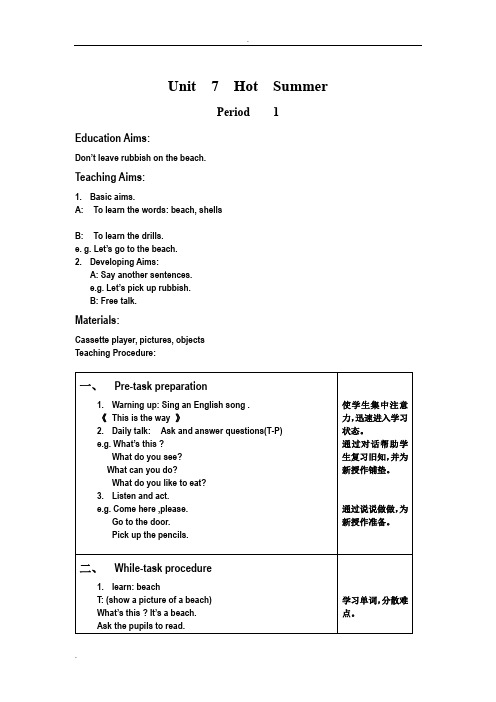
Unit 7 Hot SummerPeriod 1 Education Aims:Don’t leave rubbish on the beach.Teaching Aims:1.Basic aims.A: To learn the words: beach, shellsB: To learn the drills.e. g. Let’s go to the beach.2.Developing Aims:A: Say another sentences.e.g. Let’s pick up rubbish.B: Free talk.Materials:Cassette player, pictures, objectsTeaching Procedure:Unit 7 Hot SummerPeriod 2 Let’s talk Education Aims:To be friendly each other .Teaching Aims:1.Learn the drills.e.g. Summer is hot .2.Learn the dialogue.A: I’m sorry.B: It’s OK.Materials: cassette player, pictures, objects. Teaching Procedure:Unit 7 Hot summerPeriod 3 Let’s learn Education Aims:Don’t eat much ice-cream in summer.Teaching Aims:1.Learn the words: e.g. cloud2.Learn the letter: Y yMaterials: cassette player, word and letter cards.课后小结Period 4 Let’s play Education Aims:Don’t eat too many ice-creams.Teaching Aims:A: Basic Aims.Learn to say the sentences.e.g. The sun is hot.Let’s sit under the umbrella.B: Developing Aims.Free talk about winter.Materials: cassette player, some pictures, cards Ask the pupils to make some pictures before class.课后小结Period 5 Let’s enjoyEducation Aims:To be friendly each other .Teaching Aims:A: Basic Aims:Learn to say the rhyme.B: Developing Aims:Free talk.Materials: cassette player, pictures.。
上海版牛津英语b教案全册教案

上海版牛津英语b教案全册教案The document was prepared on January 2, 2021Unit 1 New Year第一课时(1ST PERIOD)一、主要新授内容(new contents)Let’s learn---uncle, auntLet’s talk--- How are you I am fine, thank you./ Very well, and you二、学习目标(Objectives)情感目标:1、通过在“新年”的主题中,习得拜年、串门、招待客人时可以使用的相互简单问候,让学生开始形成在日常生活中良好的语言习惯和待人接物时落落大方的态度、有问有答的礼貌。
2、在“新年到,家人、亲朋好友相互拜访”的语言使用环境中,能用正确的语音语调说出uncle, aunt两个新授词汇;能够根据家庭成员的关系在口语中正确表达uncle, aunt的称谓。
功能目标:1. 在一年级第一学期的学习基础上,能熟练运用How are you Fine, thank you./ I am fine, thank you./ Very well, and you等简单语句进行相互问候。
2.根据二期课改新课标的要求,在确保完成基本教学目标的基础上,可以结合学生的学习能力和语言的实际使用对教材呈现的教学内容进行拓展,所以在口语导入Just so-so. Not bad.等等生活中同样常用、表达意思不同的多种简单回答,有助于学生在实际生活中对语言的理解和表达更为准确和真实。
整合目标:通过信息技术与课程的整合,力求为学生提供学习的氛围,让学生在情景中展开想象。
类似导入uncle,但节奏更快、更直接地导入aunt一词,教师不用猜而直接提示:This is father’s sister. 引入aunt把语音和语义同时输入给学生。
aunt的机械性操练也可以先全体跟着教师朗读。
其中开始一两遍可以是正常声音升降调跟读,接着可以由响到轻或由轻到响地跟读。
- 1、下载文档前请自行甄别文档内容的完整性,平台不提供额外的编辑、内容补充、找答案等附加服务。
- 2、"仅部分预览"的文档,不可在线预览部分如存在完整性等问题,可反馈申请退款(可完整预览的文档不适用该条件!)。
- 3、如文档侵犯您的权益,请联系客服反馈,我们会尽快为您处理(人工客服工作时间:9:00-18:30)。
上海版牛津英语B教案文件管理序列号:[K8UY-K9IO69-O6M243-OL889-F88688]
Unit 7 Hot Summer
Period 1
Education Aims:
Don’t leave rubbish on the beach. Teaching Aims:
1.Basic aims.
A: To learn the words: beach, shells B: To learn the drills.
e. g. Let’s go to the beach.
2.Developing Aims:
A: Say another sentences.
e.g. Let’s pick up rubbish.
B: Free talk.
Materials:
Cassette player, pictures, objects Teaching Procedure:
课后小结
Unit 7 Hot Summer
Period 2 Let’s talk Education Aims:
To be friendly each other .
Teaching Aims:
1.Learn the drills.
e.g. Summer is hot .
2.Learn the dialogue.
A: I’m sorry.
B: It’s OK.
Materials: cassette player, pictures, objects. Teaching Procedure:
课后小结
Unit 7 Hot summer
Period 3 Let’s learn Education Aims:
Don’t eat much ice-cream in summer.
Teaching Aims:
1.Learn the words: e.g. cloud
2.Learn the letter: Y y
Materials: cassette player, word and letter cards.
Teaching procedure:
课后小结
Period 4 Let’s play Education Aims:
Don’t eat too many ice-creams.
Teaching Aims:
A: Basic Aims.
Learn to say the sentences.
e.g. The sun is hot.
Let’s sit under the umbrella.
B: Developing Aims.
Free talk about winter.
Materials: cassette player, some pictures, cards Ask the pupils to make some pictures before class. Teaching Procedure:
课后小结
Period 5 Let’s enjoy
Education Aims:
To be friendly each other .
Teaching Aims:
A: Basic Aims:
Learn to say the rhyme.
B: Developing Aims:
Free talk.
Materials: cassette player, pictures.
]Teaching Procedure:
课后小结。
